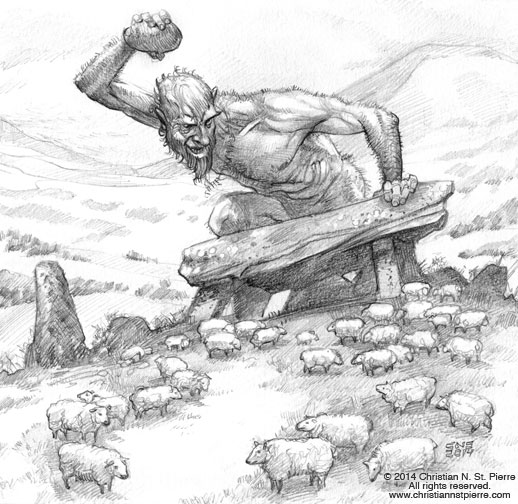Basques are known for the strong Catholic devotion. However, the Basques are also known to have converted to Christianity relatively late. Before, they had a mythology that was based on various supernatural beings. One of those was the Jentilak, or race of giants. These beings, immense in size, existed before humans, though maybe co-existed with humans, at least in some tales. They had enormous strength and were responsible for the construction of many massive stone features, including churches, castles, bridges, and dolmens. They were said to be more Christian than the Christians. They suddenly died when a black cloud appeared in the sky and they fled to bury themselves.

- The Jentilak are part of a larger European tradition of giants (think of Jack and the Beanstalk in England). “Modern” influences have corrupted the nature of these beings in these stories, but, at least in the Basque Country, they were originally benign beings.
- The Jentilak would play games, such as pilota, throwing massive stones through the air that still lie at the foot of some mountains. One rock, near Amil, a part of Motriko, becomes surrounded by water at high tides.
- The wide-spread belief in these beings is reflected in a number of place-names, including Jentilbaratza, Jentilzulo, and Jentiletxea.
- The jentilak died suddenly when the black cloud appeared, for no apparent reason (they were not punished, as in the Biblical flood, for past sins). Further, the race that succeeded them — humans — were not as kind nor “Christian” as they were. This has led scholars to interpret these myths as the foundation of religious rites of burial. As translated from the original article in the Enciclopedia Auñamendi: The Jentilak die and are buried under funerary monuments that perpetuate their memory (they die precisely to be buried) and in this way the humans who take them as models learn that they also have to act in the same way with their own deceased: burying them and guarding their memory. This is reflected in the fact that the main cultural obligation in the ancient pagan religion of the Basques consisted in the daily realization of offerings to the deceased of the house.
- In time, the cloud was reinterpreted as a portent of the coming of Kixmi, or Christ. Olentzero, the Basque “Santa Claus,” was a jentil who, being nearly blind, could look at the cloud and understood its meaning.
Source: Hartsuaga Uranga, Juan Inazio; Hartsuaga Uranga, Juan Inazio. Gentiles. Enciclopedia Auñamendi [en línea], 2019. Available at: http://aunamendi.eusko-ikaskuntza.eus/es/gentiles/ar-62712/
Thanks to Lisa Van De Graaff for suggesting this topic as a Basque Fact of the Week. If you have a topic you’d like to suggest, just let me know!
Discover more from Buber's Basque Page
Subscribe to get the latest posts sent to your email.


4 thoughts on “Basque Fact of the Week: In Basque Mythology, Before Humans, There Was a Race of Giants”